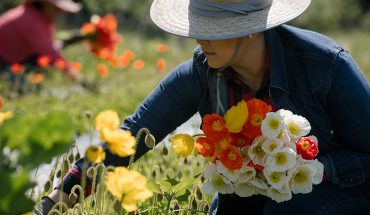by Ann Brooke Raynal
Visitors walking the streets of Historic Oakwood on a chilly December night may think they have been transported back to the 19th century. Candles burn in the windows, garlands of greenery grace the exteriors of Queen Anne, Neoclassical, and Second Empire style houses. Majestic interiors reveal high ceilings, fine woodwork, beautiful furnishings, and most important of all, old-fashioned Oakwood neighbors.
More than 200 volunteers make a night like this at the annual December Candelight Tour possible. It’s an impressive number, one that reflects this unusually cohesive community. Because Historic Oakwood, a roughly 30-block neighborhood just northwest of downtown, is much more than a zip code. It has its own website, newsletter, meeting house, and garden club. It’s filled with dedicated, like-minded people determined to preserve its history. In many ways, a visit to Oakwood can feel like stepping into a beautiful village filled with close friends.
But it wasn’t always this way.
It’s true that Oakwood enjoyed a heyday into the early 20th century, when prosperous Raleighites built large and fanciful Victorian houses by the dozen along wide, shady streets. But by the end of World War II, the neighborhood had fallen into disrepair. By the 1950s and ’60s, many of these odd houses had been chopped up into apartments by aging landlords. Neglected houses sagged on their foundations. Paint chipped and peeled away. Prostitutes and drug dealers loitered on the streets. The state threatened to run a four-lane north-south expressway through the middle of it all, a proposal that would have destroyed the only intact – if decrepit – 19th-century neighborhood in Raleigh.
Then, in 1971, a small group of Oakwood residents banded together. The highway would ruin their neighborhood once and for all, they realized – something they couldn’t allow. Together they formed the Society for the Preservation of Historic Oakwood, whose mission was to save these old treasures not only from the highway, but also from decay and neglect.
Oakwood’s rebirth was just beginning.
Preserving history
Today, Oakwood is more than intact; it’s thriving. How did it get from there to here?
In an effort to answer that question, the preservation group commissioned Oakwood resident and documentarian Liisa Ogburn to interview and photograph residents, preserving their stories for future generations.
Ogburn, who directs the Lewis Hine Documentary Fellows Program at Duke University, interviewed many of the residents herself, and also trained several neighbors in taking oral history. She used a model created by Story Corps, the national nonprofit whose stories are often broadcast on National Public Radio.
More than 80 Oakwood residents participated in one way or another, collecting more than 50 stories. These reflect every decade from the ’30s to the present.
The bravery and hope of those early ’70s pioneers, many of whom were gay men, shine through in almost every interview. These men formed an unlikely alliance with several older women in the neighborhood who were still clinging to their homes, and together they cast a vision for the future of Oakwood: It would be welcoming; it would be inclusive; it would – eventually – be beautiful.
Residents had to work together to make the transformation possible. “Someone new would arrive in the neighborhood and be doing demolition, and people would just show up to help,” Ogburn says. Neighbors would introduce themselves and immediately roll up their sleeves. They would bring over tools. And meals. They were just so grateful that another family was going to help them take the block back.”
“I purchased my house at 517 N. East Street in October 1972,” says longtime resident Ronnie Ellis. “And my parents thought I had really sort of lost it, because Oakwood at that time was basically a slum, just a very seedy neighborhood. But I had friends here.”
Barbara Wishy moved to the neighborhood in 1974 and over the years has restored and re-sold 12 houses on her own. “Oakwood was very blighted at the time, but I didn’t see any of that,” she says. “I just saw the fabulous architecture. And was totally taken with that. And bought the house which, I thought, was wonderful. And it was only once I had closed the sale and was sitting in front of the house the next morning that I looked around and said, ‘Barbara, what have you done?’ But I have never regretted it . . . It’s been a wonderful experience.”
Lighting the way
Oakwood residents love to tell the story of the heady first days of their candlelight tour, which they organized to raise money to fight the highway.
No one had any money. No one had enough furnishings. People pooled furniture and decorations to make the houses on tour look good. Ronnie Ellis recalls the contagious sense of adventure. The night before the tour, “you’d look out the window, and you’d see somebody moving a sofa to somebody’s house because they didn’t have a sofa and they needed a sofa to have in the living room for the tour. So it was quite fun.”
Longtime resident Eric Ennis’s house was on the first house tour, but despite working around the clock, it wasn’t quite ready: “I had the hallway painted…What I called the den, or the library, I didn’t have finished, and someone said, ‘Well, you just better close the door so people don’t see that.’ And I said, ‘No, this is all about restoration,’ so I pulled in some stepladders and I set buckets of paint around and paint brushes and wallpaper books and things like that to show that this is a restoration in progress. And that was one of the rooms that most people commented on because they could see what was going to happen.”
That first candlelight tour in 1971 took in $400, and all of the proceeds went into making flyers and posters to stave off the proposed highway.
Every year thereafter, the tour money has gone into the preservation society fund to help others move into Oakwood. Last year, the tour grossed more than $10,000.
Barbara Wishy chaired the first “revolving fund” committee, which provides funding for new residents to buy houses, which they then promise to restore. Lisa Finaldi and husband Brian Starkey were beneficiaries. “The revolving fund allowed us to purchase our first home where we raised our son and became part of a wonderful neighborhood,” says Lisa Finaldi. “We took the house out of its downward spiral of neglect and contributed to Oakwood’s revitalization.”
More than 40 years after the society’s founding, Oakwood shines like a beacon. Children play in the leafy neighborhood park, funded in part by the group. Neighbors walk their dogs in safety, or sit on their wide front porches and visit with one another. The “Oakwood News” is delivered by hand once a month, and each issue details some fun get-together or community event. “It’s the fact that you have this network of friendships and joint efforts that continue over time,” says resident Peter Rumsey. “I think it’s absolutely unmatched by any place that I have seen in the country. It is a family consisting of all of the variety and the full spectrum of uncles and aunts and grandfathers and ogres and the rest. I love it.”
The 42nd annual candlelight tour is Dec. 7-8. For tickets and more information, go to historicoakwood.org. The society’s documentary stories are also posted there.







